Managing a Successful Business Project
VerifiedAdded on 2020/10/22
|32
|7101
|217
Project
AI Summary
This project examines the positive ethical, cultural, and economic impacts of globalization on various business functions at John Lewis. It includes a project management plan, research methodology, data analysis, and reflections on the findings. The study highlights the importance of adapting marketing strategies to different cultures and the overall benefits of globalization for business growth.
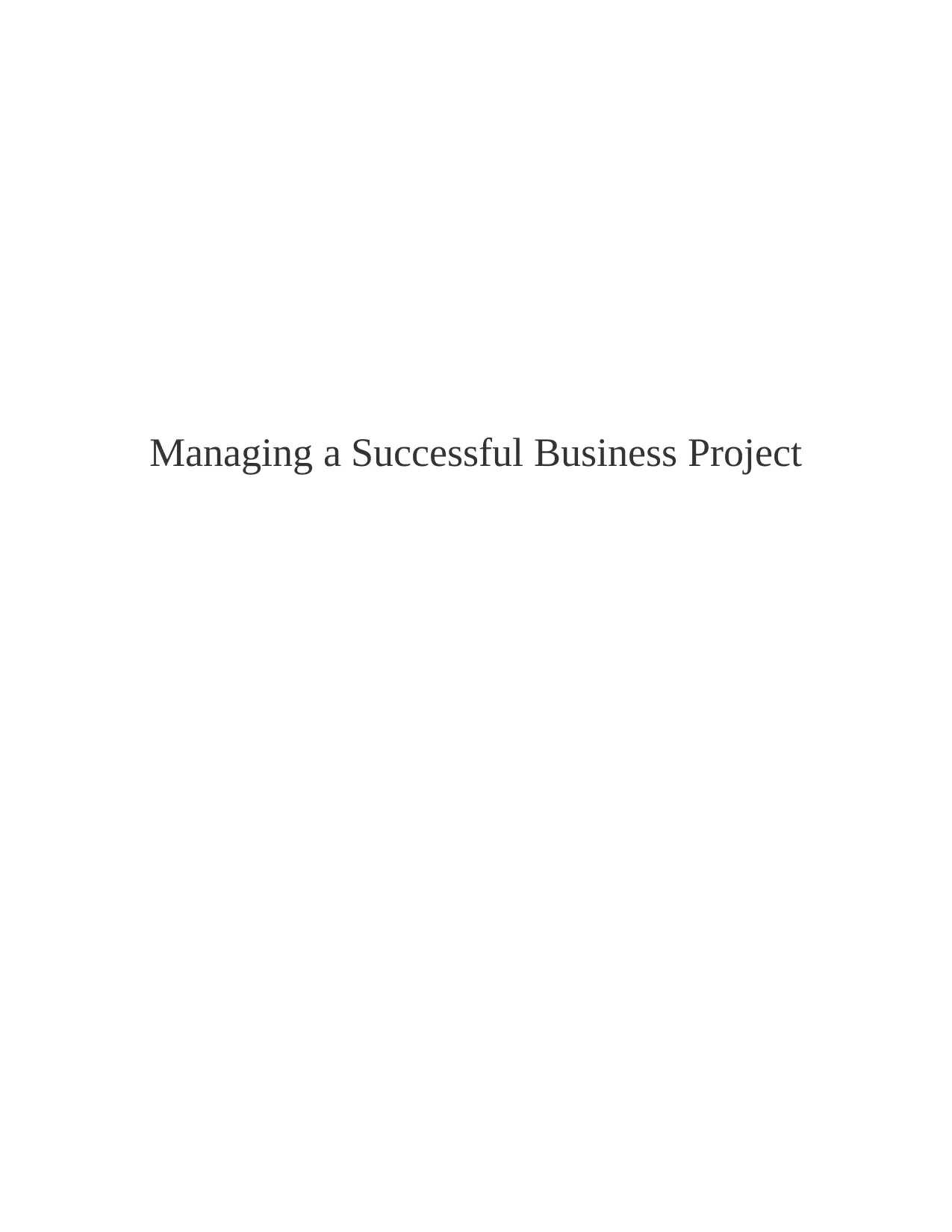
Managing a Successful Business Project
Paraphrase This Document
Need a fresh take? Get an instant paraphrase of this document with our AI Paraphraser
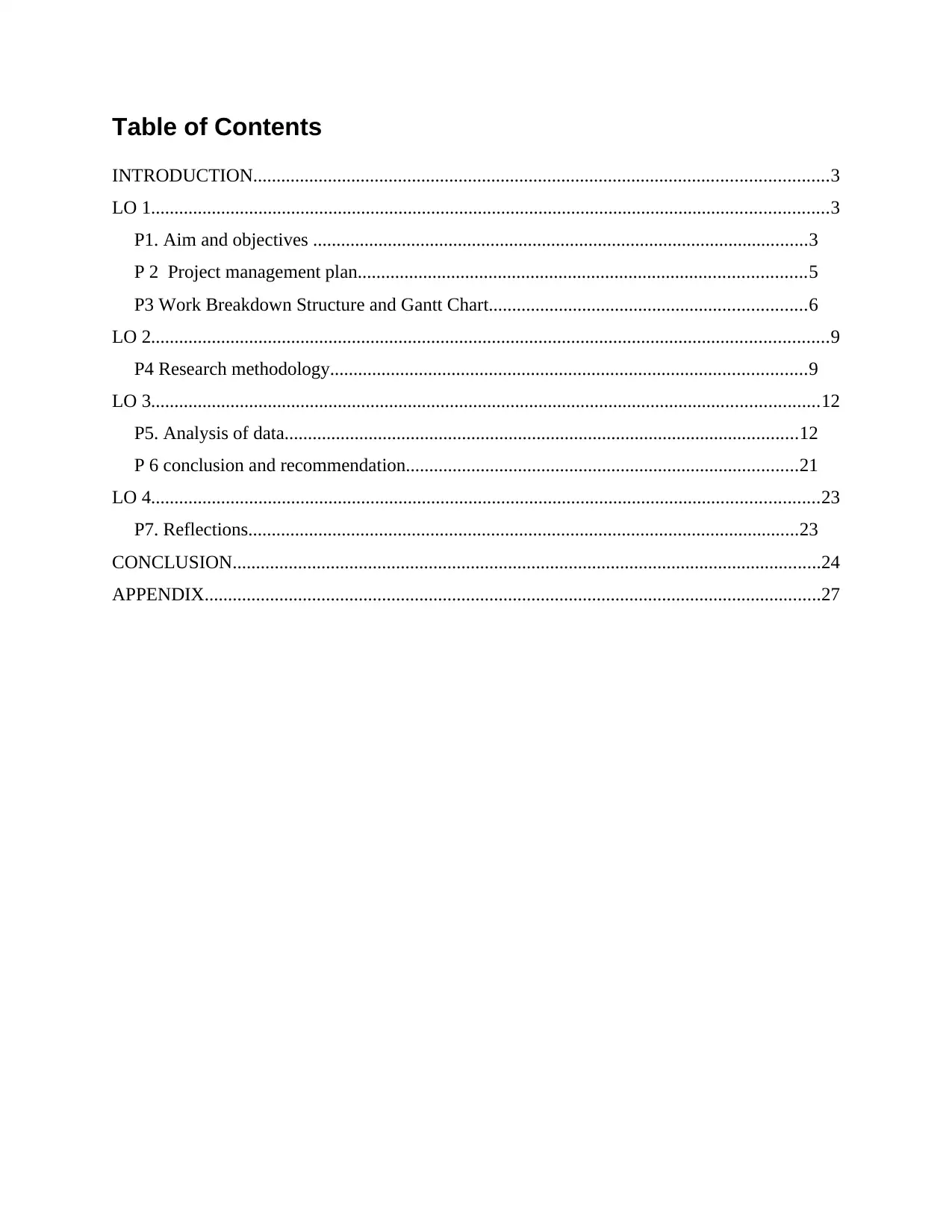
Table of Contents
INTRODUCTION...........................................................................................................................3
LO 1.................................................................................................................................................3
P1. Aim and objectives ..........................................................................................................3
P 2 Project management plan................................................................................................5
P3 Work Breakdown Structure and Gantt Chart....................................................................6
LO 2.................................................................................................................................................9
P4 Research methodology......................................................................................................9
LO 3...............................................................................................................................................12
P5. Analysis of data..............................................................................................................12
P 6 conclusion and recommendation....................................................................................21
LO 4...............................................................................................................................................23
P7. Reflections......................................................................................................................23
CONCLUSION..............................................................................................................................24
APPENDIX....................................................................................................................................27
INTRODUCTION...........................................................................................................................3
LO 1.................................................................................................................................................3
P1. Aim and objectives ..........................................................................................................3
P 2 Project management plan................................................................................................5
P3 Work Breakdown Structure and Gantt Chart....................................................................6
LO 2.................................................................................................................................................9
P4 Research methodology......................................................................................................9
LO 3...............................................................................................................................................12
P5. Analysis of data..............................................................................................................12
P 6 conclusion and recommendation....................................................................................21
LO 4...............................................................................................................................................23
P7. Reflections......................................................................................................................23
CONCLUSION..............................................................................................................................24
APPENDIX....................................................................................................................................27
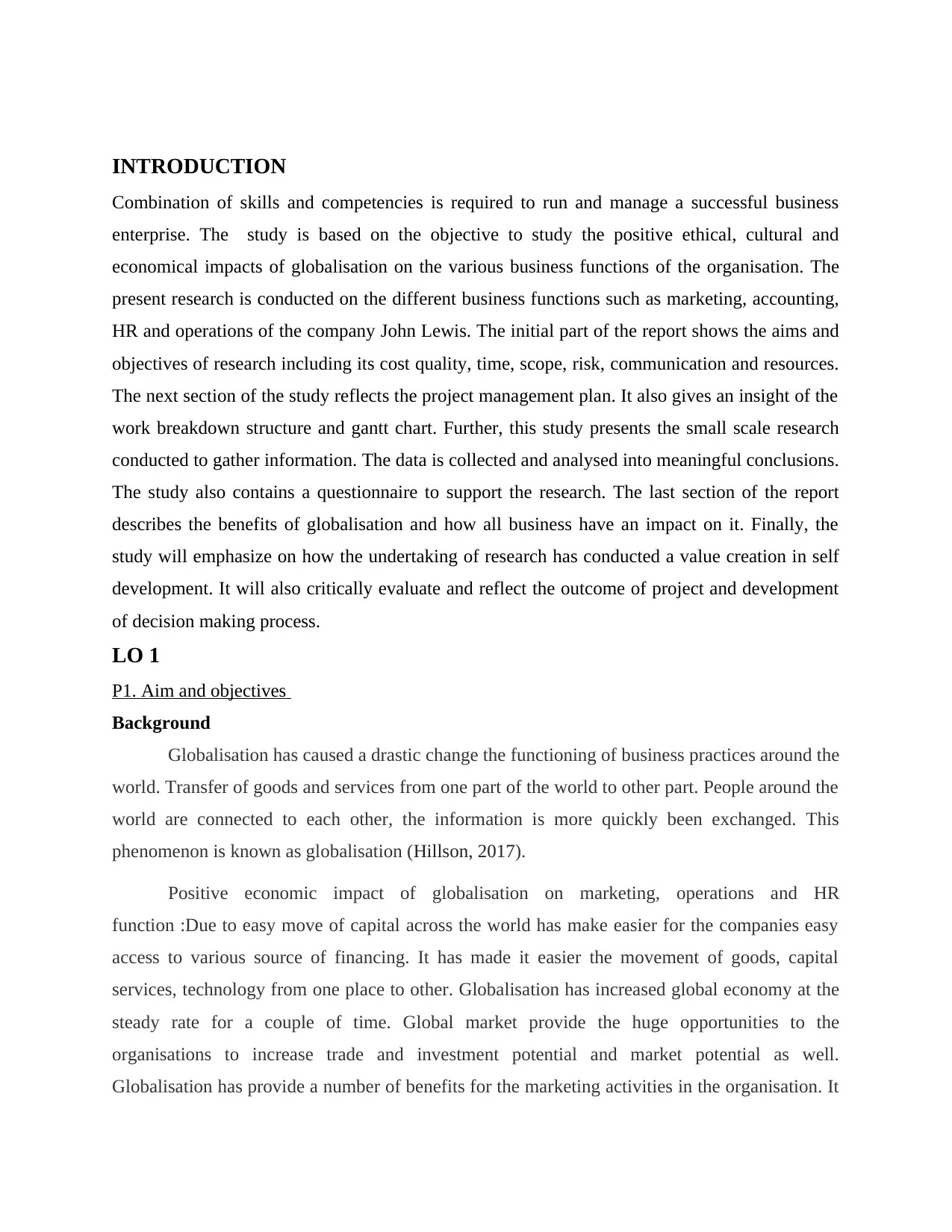
INTRODUCTION
Combination of skills and competencies is required to run and manage a successful business
enterprise. The study is based on the objective to study the positive ethical, cultural and
economical impacts of globalisation on the various business functions of the organisation. The
present research is conducted on the different business functions such as marketing, accounting,
HR and operations of the company John Lewis. The initial part of the report shows the aims and
objectives of research including its cost quality, time, scope, risk, communication and resources.
The next section of the study reflects the project management plan. It also gives an insight of the
work breakdown structure and gantt chart. Further, this study presents the small scale research
conducted to gather information. The data is collected and analysed into meaningful conclusions.
The study also contains a questionnaire to support the research. The last section of the report
describes the benefits of globalisation and how all business have an impact on it. Finally, the
study will emphasize on how the undertaking of research has conducted a value creation in self
development. It will also critically evaluate and reflect the outcome of project and development
of decision making process.
LO 1
P1. Aim and objectives
Background
Globalisation has caused a drastic change the functioning of business practices around the
world. Transfer of goods and services from one part of the world to other part. People around the
world are connected to each other, the information is more quickly been exchanged. This
phenomenon is known as globalisation (Hillson, 2017).
Positive economic impact of globalisation on marketing, operations and HR
function :Due to easy move of capital across the world has make easier for the companies easy
access to various source of financing. It has made it easier the movement of goods, capital
services, technology from one place to other. Globalisation has increased global economy at the
steady rate for a couple of time. Global market provide the huge opportunities to the
organisations to increase trade and investment potential and market potential as well.
Globalisation has provide a number of benefits for the marketing activities in the organisation. It
Combination of skills and competencies is required to run and manage a successful business
enterprise. The study is based on the objective to study the positive ethical, cultural and
economical impacts of globalisation on the various business functions of the organisation. The
present research is conducted on the different business functions such as marketing, accounting,
HR and operations of the company John Lewis. The initial part of the report shows the aims and
objectives of research including its cost quality, time, scope, risk, communication and resources.
The next section of the study reflects the project management plan. It also gives an insight of the
work breakdown structure and gantt chart. Further, this study presents the small scale research
conducted to gather information. The data is collected and analysed into meaningful conclusions.
The study also contains a questionnaire to support the research. The last section of the report
describes the benefits of globalisation and how all business have an impact on it. Finally, the
study will emphasize on how the undertaking of research has conducted a value creation in self
development. It will also critically evaluate and reflect the outcome of project and development
of decision making process.
LO 1
P1. Aim and objectives
Background
Globalisation has caused a drastic change the functioning of business practices around the
world. Transfer of goods and services from one part of the world to other part. People around the
world are connected to each other, the information is more quickly been exchanged. This
phenomenon is known as globalisation (Hillson, 2017).
Positive economic impact of globalisation on marketing, operations and HR
function :Due to easy move of capital across the world has make easier for the companies easy
access to various source of financing. It has made it easier the movement of goods, capital
services, technology from one place to other. Globalisation has increased global economy at the
steady rate for a couple of time. Global market provide the huge opportunities to the
organisations to increase trade and investment potential and market potential as well.
Globalisation has provide a number of benefits for the marketing activities in the organisation. It
⊘ This is a preview!⊘
Do you want full access?
Subscribe today to unlock all pages.

Trusted by 1+ million students worldwide
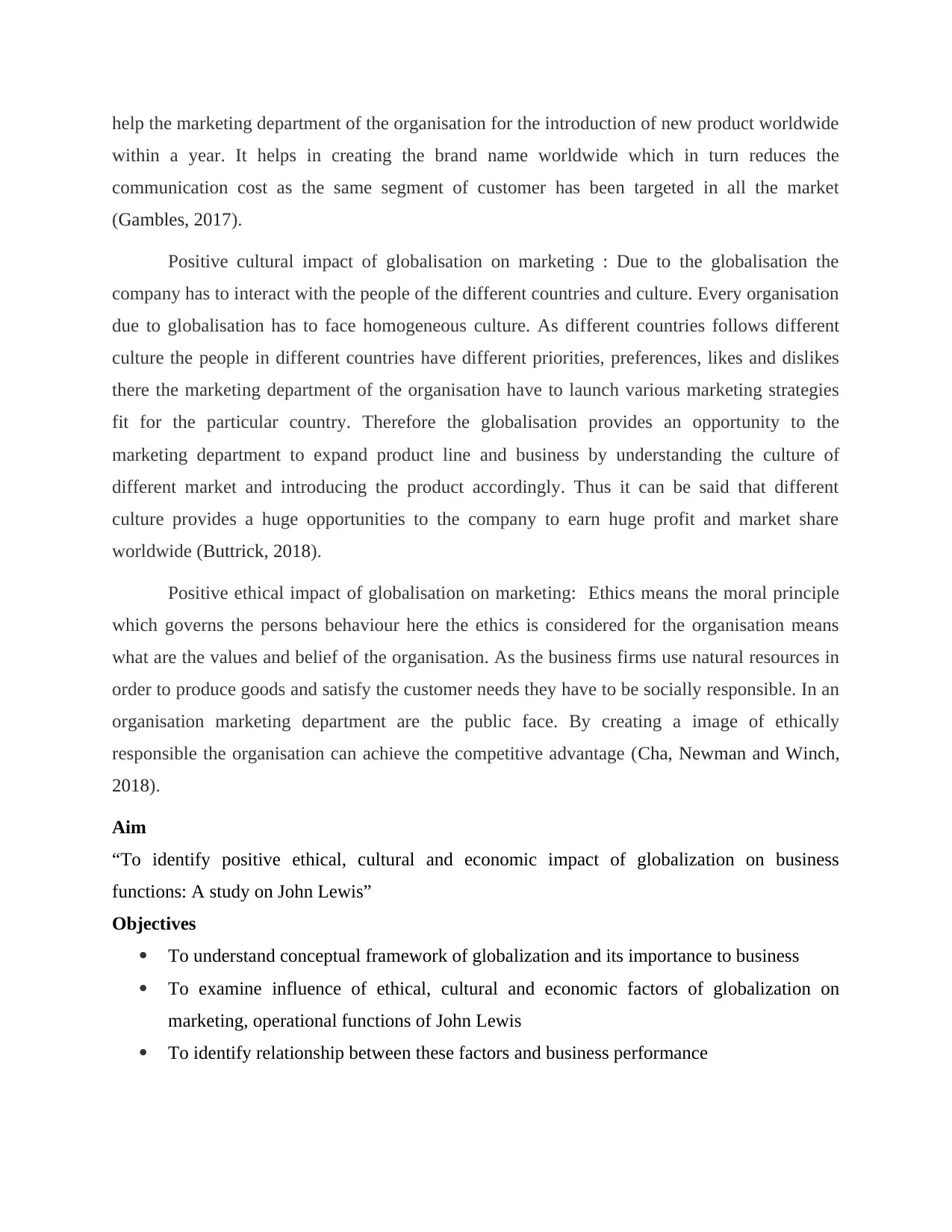
help the marketing department of the organisation for the introduction of new product worldwide
within a year. It helps in creating the brand name worldwide which in turn reduces the
communication cost as the same segment of customer has been targeted in all the market
(Gambles, 2017).
Positive cultural impact of globalisation on marketing : Due to the globalisation the
company has to interact with the people of the different countries and culture. Every organisation
due to globalisation has to face homogeneous culture. As different countries follows different
culture the people in different countries have different priorities, preferences, likes and dislikes
there the marketing department of the organisation have to launch various marketing strategies
fit for the particular country. Therefore the globalisation provides an opportunity to the
marketing department to expand product line and business by understanding the culture of
different market and introducing the product accordingly. Thus it can be said that different
culture provides a huge opportunities to the company to earn huge profit and market share
worldwide (Buttrick, 2018).
Positive ethical impact of globalisation on marketing: Ethics means the moral principle
which governs the persons behaviour here the ethics is considered for the organisation means
what are the values and belief of the organisation. As the business firms use natural resources in
order to produce goods and satisfy the customer needs they have to be socially responsible. In an
organisation marketing department are the public face. By creating a image of ethically
responsible the organisation can achieve the competitive advantage (Cha, Newman and Winch,
2018).
Aim
“To identify positive ethical, cultural and economic impact of globalization on business
functions: A study on John Lewis”
Objectives
To understand conceptual framework of globalization and its importance to business
To examine influence of ethical, cultural and economic factors of globalization on
marketing, operational functions of John Lewis
To identify relationship between these factors and business performance
within a year. It helps in creating the brand name worldwide which in turn reduces the
communication cost as the same segment of customer has been targeted in all the market
(Gambles, 2017).
Positive cultural impact of globalisation on marketing : Due to the globalisation the
company has to interact with the people of the different countries and culture. Every organisation
due to globalisation has to face homogeneous culture. As different countries follows different
culture the people in different countries have different priorities, preferences, likes and dislikes
there the marketing department of the organisation have to launch various marketing strategies
fit for the particular country. Therefore the globalisation provides an opportunity to the
marketing department to expand product line and business by understanding the culture of
different market and introducing the product accordingly. Thus it can be said that different
culture provides a huge opportunities to the company to earn huge profit and market share
worldwide (Buttrick, 2018).
Positive ethical impact of globalisation on marketing: Ethics means the moral principle
which governs the persons behaviour here the ethics is considered for the organisation means
what are the values and belief of the organisation. As the business firms use natural resources in
order to produce goods and satisfy the customer needs they have to be socially responsible. In an
organisation marketing department are the public face. By creating a image of ethically
responsible the organisation can achieve the competitive advantage (Cha, Newman and Winch,
2018).
Aim
“To identify positive ethical, cultural and economic impact of globalization on business
functions: A study on John Lewis”
Objectives
To understand conceptual framework of globalization and its importance to business
To examine influence of ethical, cultural and economic factors of globalization on
marketing, operational functions of John Lewis
To identify relationship between these factors and business performance
Paraphrase This Document
Need a fresh take? Get an instant paraphrase of this document with our AI Paraphraser
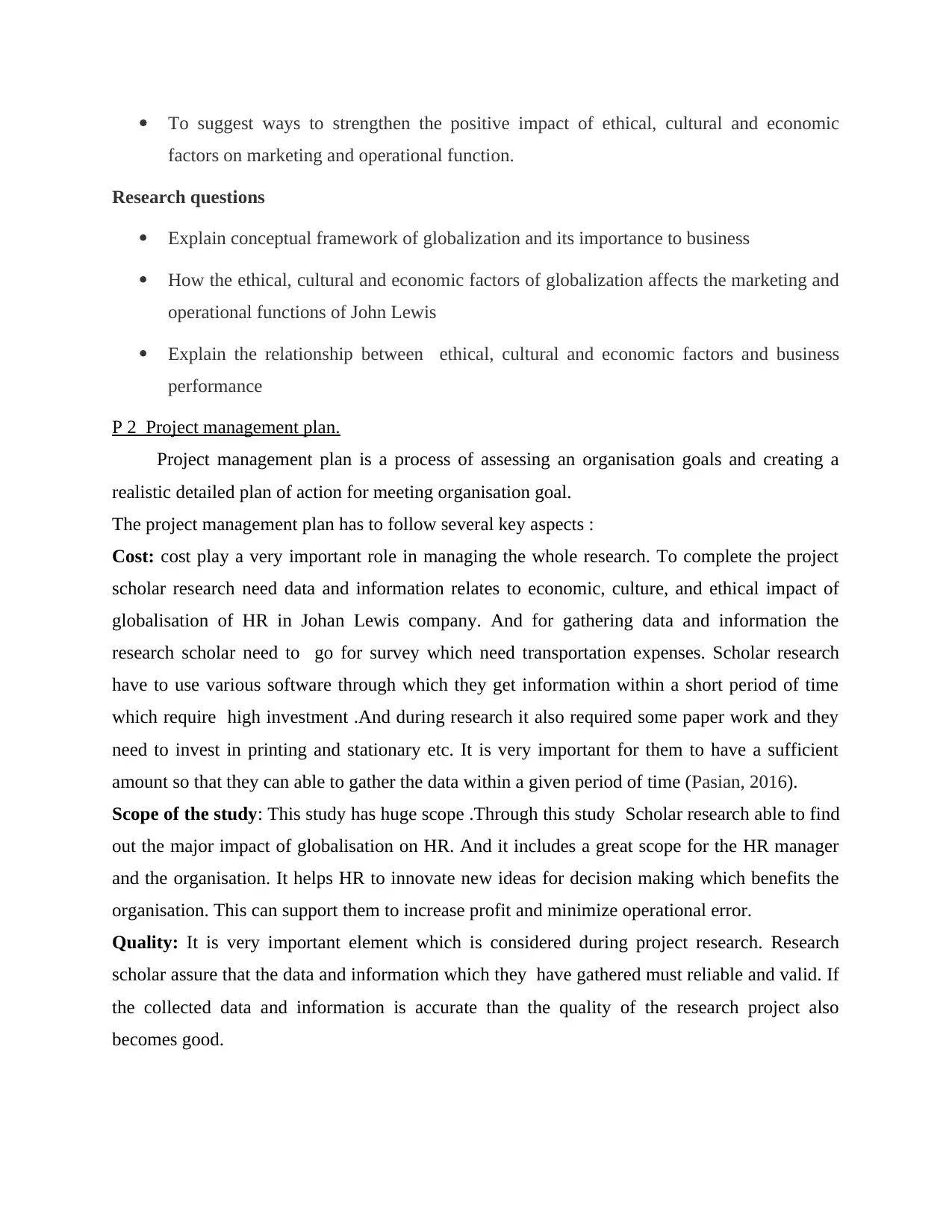
To suggest ways to strengthen the positive impact of ethical, cultural and economic
factors on marketing and operational function.
Research questions
Explain conceptual framework of globalization and its importance to business
How the ethical, cultural and economic factors of globalization affects the marketing and
operational functions of John Lewis
Explain the relationship between ethical, cultural and economic factors and business
performance
P 2 Project management plan.
Project management plan is a process of assessing an organisation goals and creating a
realistic detailed plan of action for meeting organisation goal.
The project management plan has to follow several key aspects :
Cost: cost play a very important role in managing the whole research. To complete the project
scholar research need data and information relates to economic, culture, and ethical impact of
globalisation of HR in Johan Lewis company. And for gathering data and information the
research scholar need to go for survey which need transportation expenses. Scholar research
have to use various software through which they get information within a short period of time
which require high investment .And during research it also required some paper work and they
need to invest in printing and stationary etc. It is very important for them to have a sufficient
amount so that they can able to gather the data within a given period of time (Pasian, 2016).
Scope of the study: This study has huge scope .Through this study Scholar research able to find
out the major impact of globalisation on HR. And it includes a great scope for the HR manager
and the organisation. It helps HR to innovate new ideas for decision making which benefits the
organisation. This can support them to increase profit and minimize operational error.
Quality: It is very important element which is considered during project research. Research
scholar assure that the data and information which they have gathered must reliable and valid. If
the collected data and information is accurate than the quality of the research project also
becomes good.
factors on marketing and operational function.
Research questions
Explain conceptual framework of globalization and its importance to business
How the ethical, cultural and economic factors of globalization affects the marketing and
operational functions of John Lewis
Explain the relationship between ethical, cultural and economic factors and business
performance
P 2 Project management plan.
Project management plan is a process of assessing an organisation goals and creating a
realistic detailed plan of action for meeting organisation goal.
The project management plan has to follow several key aspects :
Cost: cost play a very important role in managing the whole research. To complete the project
scholar research need data and information relates to economic, culture, and ethical impact of
globalisation of HR in Johan Lewis company. And for gathering data and information the
research scholar need to go for survey which need transportation expenses. Scholar research
have to use various software through which they get information within a short period of time
which require high investment .And during research it also required some paper work and they
need to invest in printing and stationary etc. It is very important for them to have a sufficient
amount so that they can able to gather the data within a given period of time (Pasian, 2016).
Scope of the study: This study has huge scope .Through this study Scholar research able to find
out the major impact of globalisation on HR. And it includes a great scope for the HR manager
and the organisation. It helps HR to innovate new ideas for decision making which benefits the
organisation. This can support them to increase profit and minimize operational error.
Quality: It is very important element which is considered during project research. Research
scholar assure that the data and information which they have gathered must reliable and valid. If
the collected data and information is accurate than the quality of the research project also
becomes good.
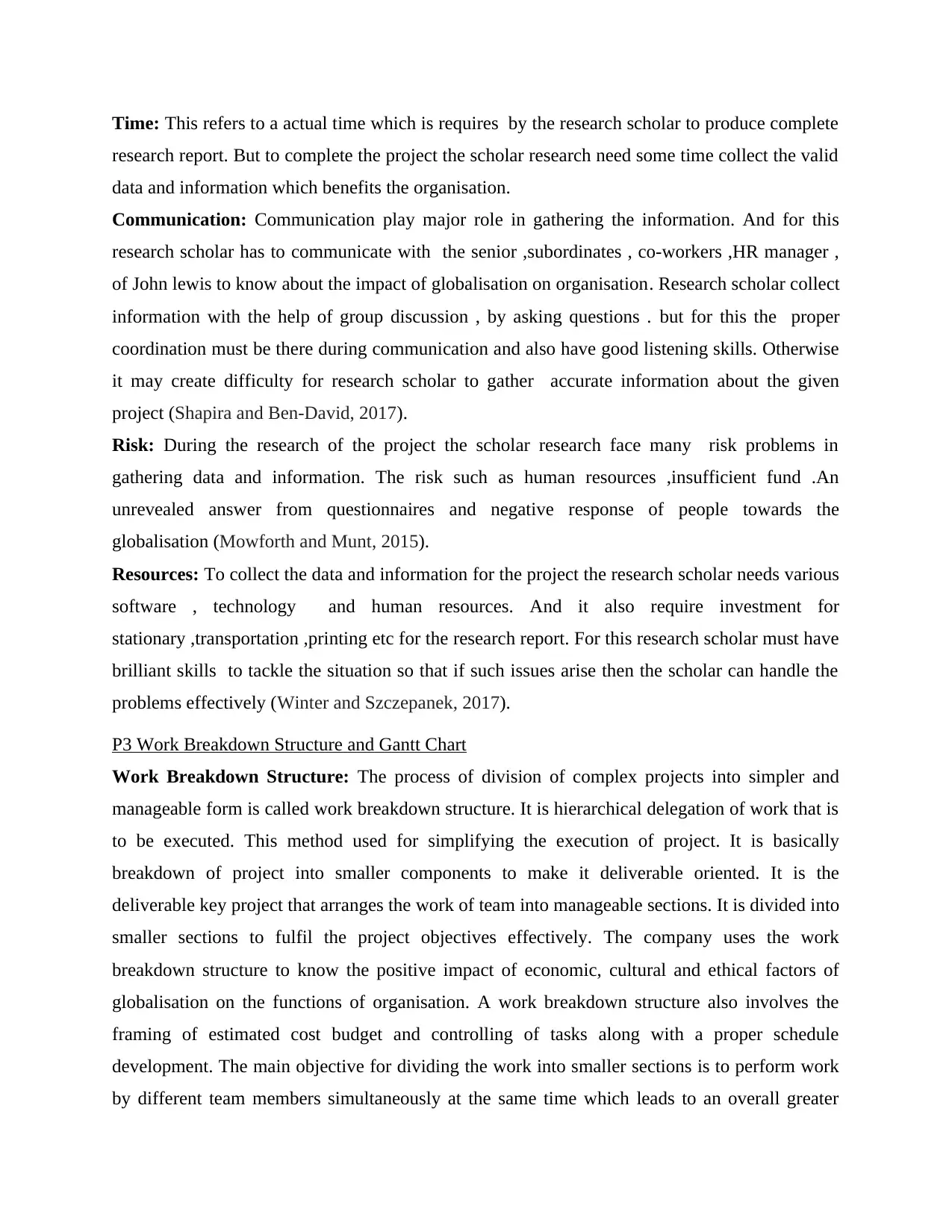
Time: This refers to a actual time which is requires by the research scholar to produce complete
research report. But to complete the project the scholar research need some time collect the valid
data and information which benefits the organisation.
Communication: Communication play major role in gathering the information. And for this
research scholar has to communicate with the senior ,subordinates , co-workers ,HR manager ,
of John lewis to know about the impact of globalisation on organisation. Research scholar collect
information with the help of group discussion , by asking questions . but for this the proper
coordination must be there during communication and also have good listening skills. Otherwise
it may create difficulty for research scholar to gather accurate information about the given
project (Shapira and Ben-David, 2017).
Risk: During the research of the project the scholar research face many risk problems in
gathering data and information. The risk such as human resources ,insufficient fund .An
unrevealed answer from questionnaires and negative response of people towards the
globalisation (Mowforth and Munt, 2015).
Resources: To collect the data and information for the project the research scholar needs various
software , technology and human resources. And it also require investment for
stationary ,transportation ,printing etc for the research report. For this research scholar must have
brilliant skills to tackle the situation so that if such issues arise then the scholar can handle the
problems effectively (Winter and Szczepanek, 2017).
P3 Work Breakdown Structure and Gantt Chart
Work Breakdown Structure: The process of division of complex projects into simpler and
manageable form is called work breakdown structure. It is hierarchical delegation of work that is
to be executed. This method used for simplifying the execution of project. It is basically
breakdown of project into smaller components to make it deliverable oriented. It is the
deliverable key project that arranges the work of team into manageable sections. It is divided into
smaller sections to fulfil the project objectives effectively. The company uses the work
breakdown structure to know the positive impact of economic, cultural and ethical factors of
globalisation on the functions of organisation. A work breakdown structure also involves the
framing of estimated cost budget and controlling of tasks along with a proper schedule
development. The main objective for dividing the work into smaller sections is to perform work
by different team members simultaneously at the same time which leads to an overall greater
research report. But to complete the project the scholar research need some time collect the valid
data and information which benefits the organisation.
Communication: Communication play major role in gathering the information. And for this
research scholar has to communicate with the senior ,subordinates , co-workers ,HR manager ,
of John lewis to know about the impact of globalisation on organisation. Research scholar collect
information with the help of group discussion , by asking questions . but for this the proper
coordination must be there during communication and also have good listening skills. Otherwise
it may create difficulty for research scholar to gather accurate information about the given
project (Shapira and Ben-David, 2017).
Risk: During the research of the project the scholar research face many risk problems in
gathering data and information. The risk such as human resources ,insufficient fund .An
unrevealed answer from questionnaires and negative response of people towards the
globalisation (Mowforth and Munt, 2015).
Resources: To collect the data and information for the project the research scholar needs various
software , technology and human resources. And it also require investment for
stationary ,transportation ,printing etc for the research report. For this research scholar must have
brilliant skills to tackle the situation so that if such issues arise then the scholar can handle the
problems effectively (Winter and Szczepanek, 2017).
P3 Work Breakdown Structure and Gantt Chart
Work Breakdown Structure: The process of division of complex projects into simpler and
manageable form is called work breakdown structure. It is hierarchical delegation of work that is
to be executed. This method used for simplifying the execution of project. It is basically
breakdown of project into smaller components to make it deliverable oriented. It is the
deliverable key project that arranges the work of team into manageable sections. It is divided into
smaller sections to fulfil the project objectives effectively. The company uses the work
breakdown structure to know the positive impact of economic, cultural and ethical factors of
globalisation on the functions of organisation. A work breakdown structure also involves the
framing of estimated cost budget and controlling of tasks along with a proper schedule
development. The main objective for dividing the work into smaller sections is to perform work
by different team members simultaneously at the same time which leads to an overall greater
⊘ This is a preview!⊘
Do you want full access?
Subscribe today to unlock all pages.

Trusted by 1+ million students worldwide
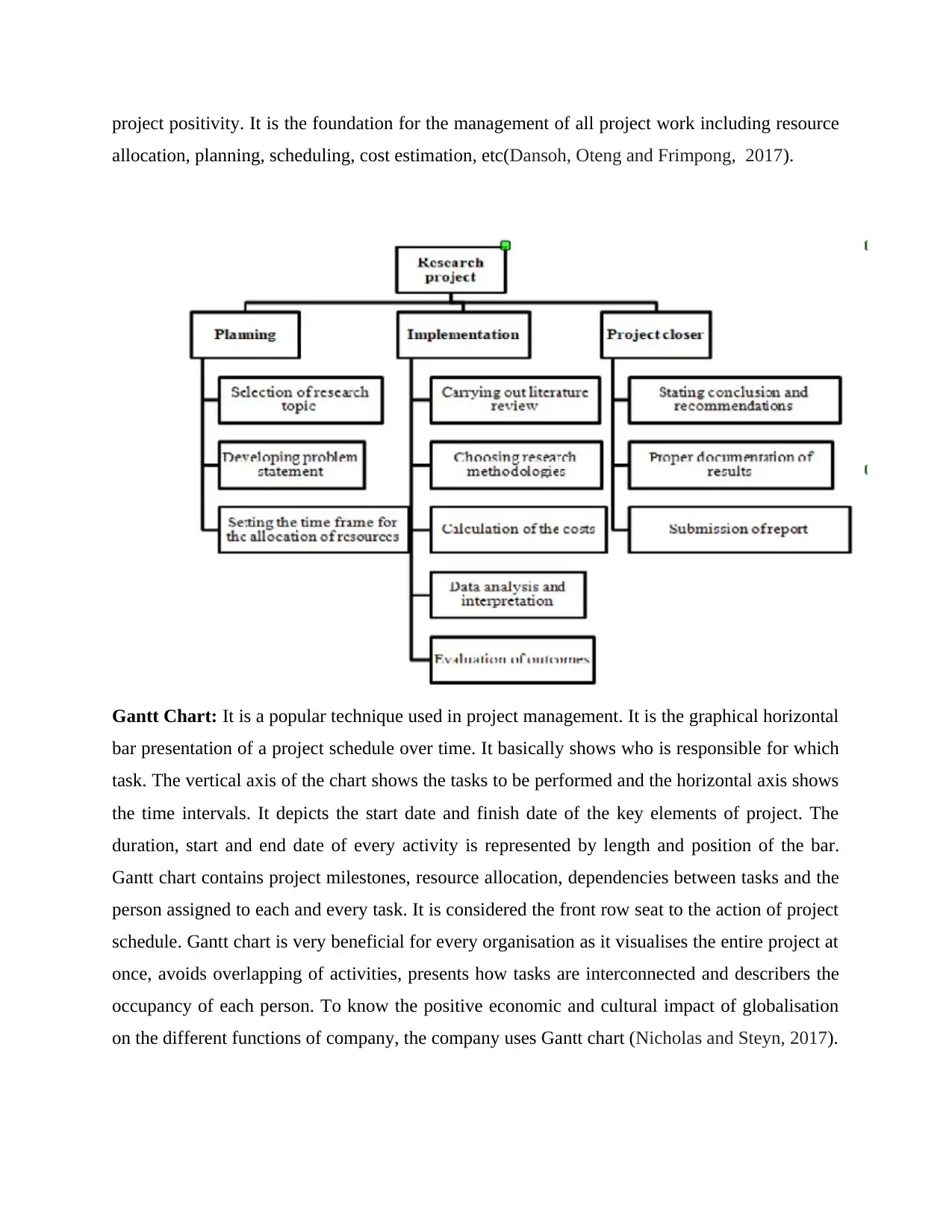
project positivity. It is the foundation for the management of all project work including resource
allocation, planning, scheduling, cost estimation, etc(Dansoh, Oteng and Frimpong, 2017).
Gantt Chart: It is a popular technique used in project management. It is the graphical horizontal
bar presentation of a project schedule over time. It basically shows who is responsible for which
task. The vertical axis of the chart shows the tasks to be performed and the horizontal axis shows
the time intervals. It depicts the start date and finish date of the key elements of project. The
duration, start and end date of every activity is represented by length and position of the bar.
Gantt chart contains project milestones, resource allocation, dependencies between tasks and the
person assigned to each and every task. It is considered the front row seat to the action of project
schedule. Gantt chart is very beneficial for every organisation as it visualises the entire project at
once, avoids overlapping of activities, presents how tasks are interconnected and describers the
occupancy of each person. To know the positive economic and cultural impact of globalisation
on the different functions of company, the company uses Gantt chart (Nicholas and Steyn, 2017).
allocation, planning, scheduling, cost estimation, etc(Dansoh, Oteng and Frimpong, 2017).
Gantt Chart: It is a popular technique used in project management. It is the graphical horizontal
bar presentation of a project schedule over time. It basically shows who is responsible for which
task. The vertical axis of the chart shows the tasks to be performed and the horizontal axis shows
the time intervals. It depicts the start date and finish date of the key elements of project. The
duration, start and end date of every activity is represented by length and position of the bar.
Gantt chart contains project milestones, resource allocation, dependencies between tasks and the
person assigned to each and every task. It is considered the front row seat to the action of project
schedule. Gantt chart is very beneficial for every organisation as it visualises the entire project at
once, avoids overlapping of activities, presents how tasks are interconnected and describers the
occupancy of each person. To know the positive economic and cultural impact of globalisation
on the different functions of company, the company uses Gantt chart (Nicholas and Steyn, 2017).
Paraphrase This Document
Need a fresh take? Get an instant paraphrase of this document with our AI Paraphraser
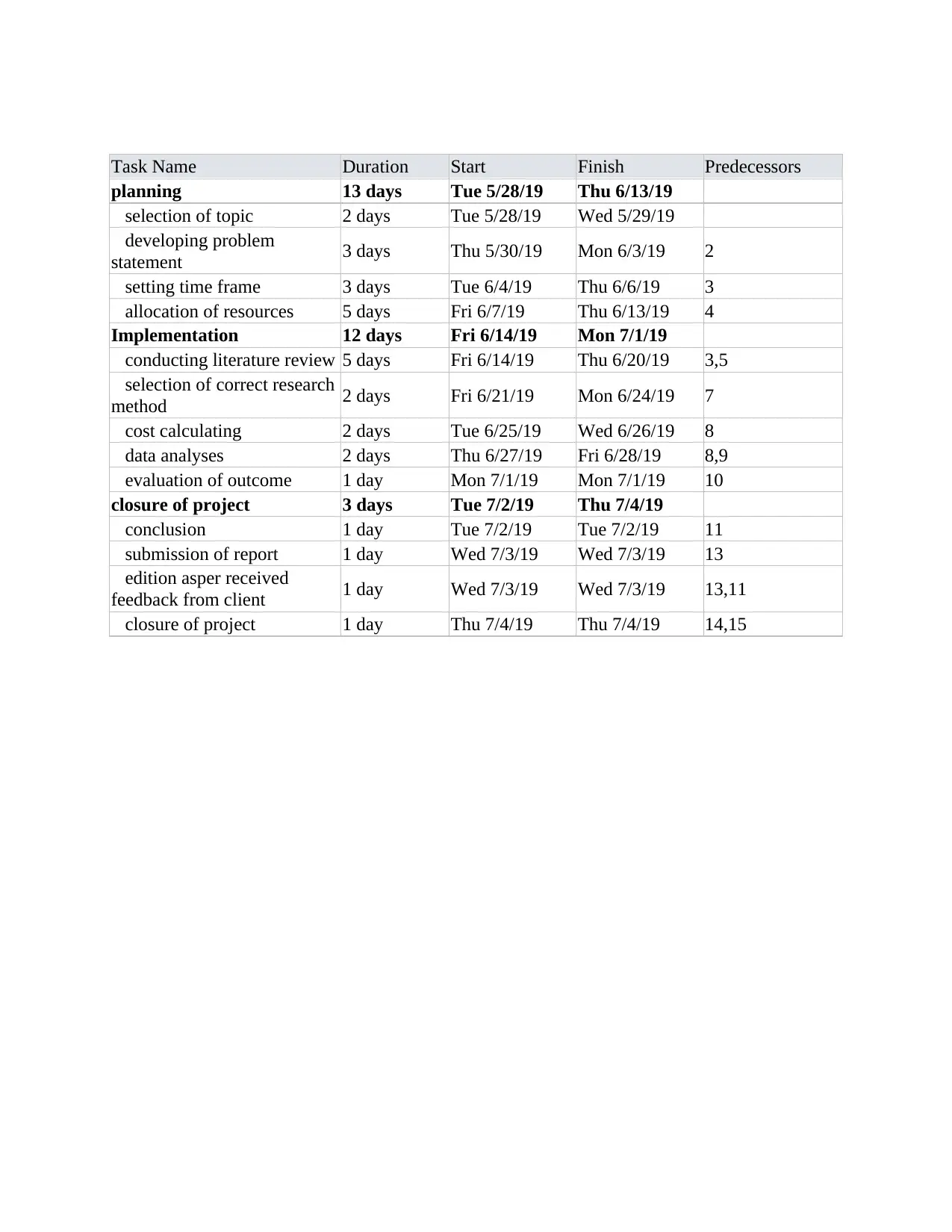
Task Name Duration Start Finish Predecessors
planning 13 days Tue 5/28/19 Thu 6/13/19
selection of topic 2 days Tue 5/28/19 Wed 5/29/19
developing problem
statement 3 days Thu 5/30/19 Mon 6/3/19 2
setting time frame 3 days Tue 6/4/19 Thu 6/6/19 3
allocation of resources 5 days Fri 6/7/19 Thu 6/13/19 4
Implementation 12 days Fri 6/14/19 Mon 7/1/19
conducting literature review 5 days Fri 6/14/19 Thu 6/20/19 3,5
selection of correct research
method 2 days Fri 6/21/19 Mon 6/24/19 7
cost calculating 2 days Tue 6/25/19 Wed 6/26/19 8
data analyses 2 days Thu 6/27/19 Fri 6/28/19 8,9
evaluation of outcome 1 day Mon 7/1/19 Mon 7/1/19 10
closure of project 3 days Tue 7/2/19 Thu 7/4/19
conclusion 1 day Tue 7/2/19 Tue 7/2/19 11
submission of report 1 day Wed 7/3/19 Wed 7/3/19 13
edition asper received
feedback from client 1 day Wed 7/3/19 Wed 7/3/19 13,11
closure of project 1 day Thu 7/4/19 Thu 7/4/19 14,15
planning 13 days Tue 5/28/19 Thu 6/13/19
selection of topic 2 days Tue 5/28/19 Wed 5/29/19
developing problem
statement 3 days Thu 5/30/19 Mon 6/3/19 2
setting time frame 3 days Tue 6/4/19 Thu 6/6/19 3
allocation of resources 5 days Fri 6/7/19 Thu 6/13/19 4
Implementation 12 days Fri 6/14/19 Mon 7/1/19
conducting literature review 5 days Fri 6/14/19 Thu 6/20/19 3,5
selection of correct research
method 2 days Fri 6/21/19 Mon 6/24/19 7
cost calculating 2 days Tue 6/25/19 Wed 6/26/19 8
data analyses 2 days Thu 6/27/19 Fri 6/28/19 8,9
evaluation of outcome 1 day Mon 7/1/19 Mon 7/1/19 10
closure of project 3 days Tue 7/2/19 Thu 7/4/19
conclusion 1 day Tue 7/2/19 Tue 7/2/19 11
submission of report 1 day Wed 7/3/19 Wed 7/3/19 13
edition asper received
feedback from client 1 day Wed 7/3/19 Wed 7/3/19 13,11
closure of project 1 day Thu 7/4/19 Thu 7/4/19 14,15
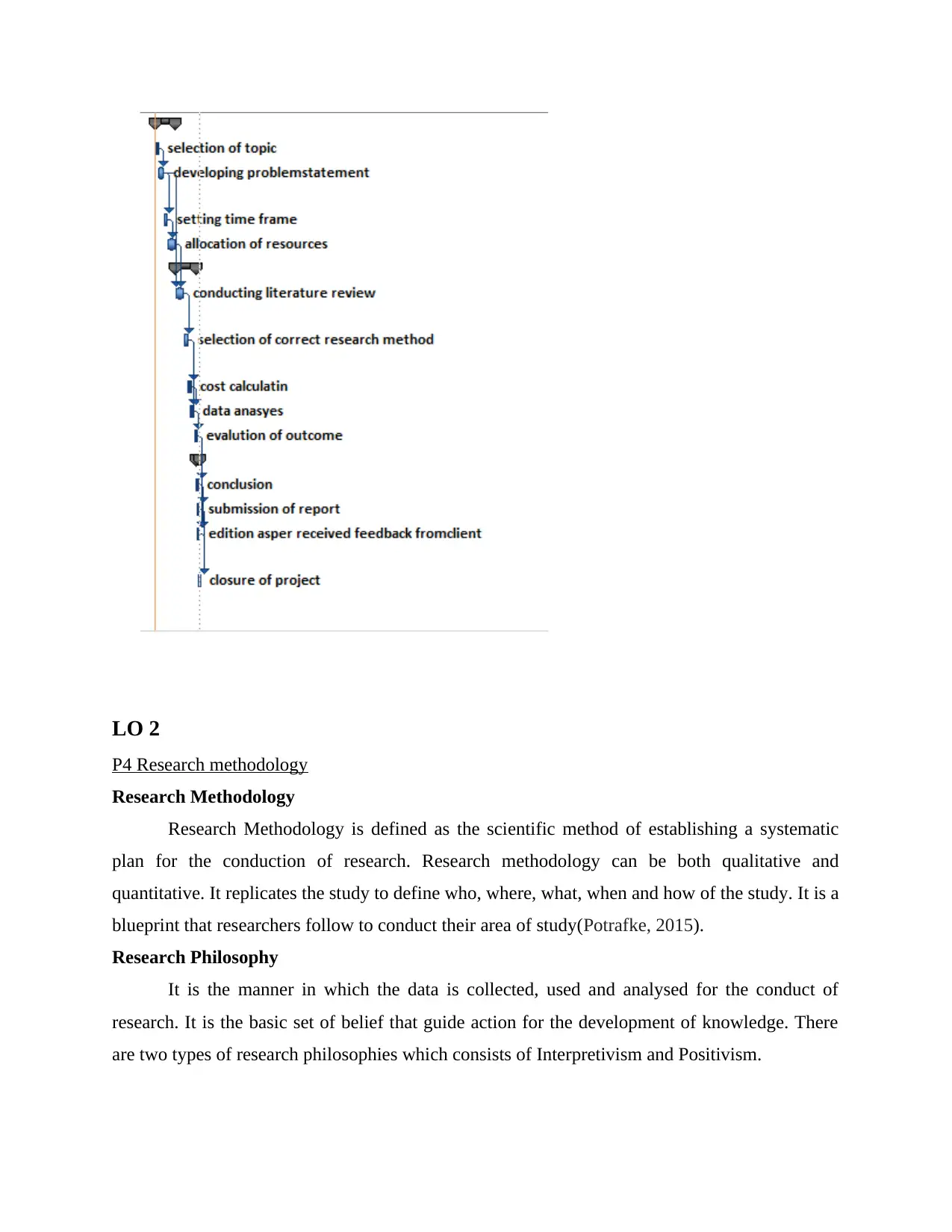
LO 2
P4 Research methodology
Research Methodology
Research Methodology is defined as the scientific method of establishing a systematic
plan for the conduction of research. Research methodology can be both qualitative and
quantitative. It replicates the study to define who, where, what, when and how of the study. It is a
blueprint that researchers follow to conduct their area of study(Potrafke, 2015).
Research Philosophy
It is the manner in which the data is collected, used and analysed for the conduct of
research. It is the basic set of belief that guide action for the development of knowledge. There
are two types of research philosophies which consists of Interpretivism and Positivism.
P4 Research methodology
Research Methodology
Research Methodology is defined as the scientific method of establishing a systematic
plan for the conduction of research. Research methodology can be both qualitative and
quantitative. It replicates the study to define who, where, what, when and how of the study. It is a
blueprint that researchers follow to conduct their area of study(Potrafke, 2015).
Research Philosophy
It is the manner in which the data is collected, used and analysed for the conduct of
research. It is the basic set of belief that guide action for the development of knowledge. There
are two types of research philosophies which consists of Interpretivism and Positivism.
⊘ This is a preview!⊘
Do you want full access?
Subscribe today to unlock all pages.

Trusted by 1+ million students worldwide
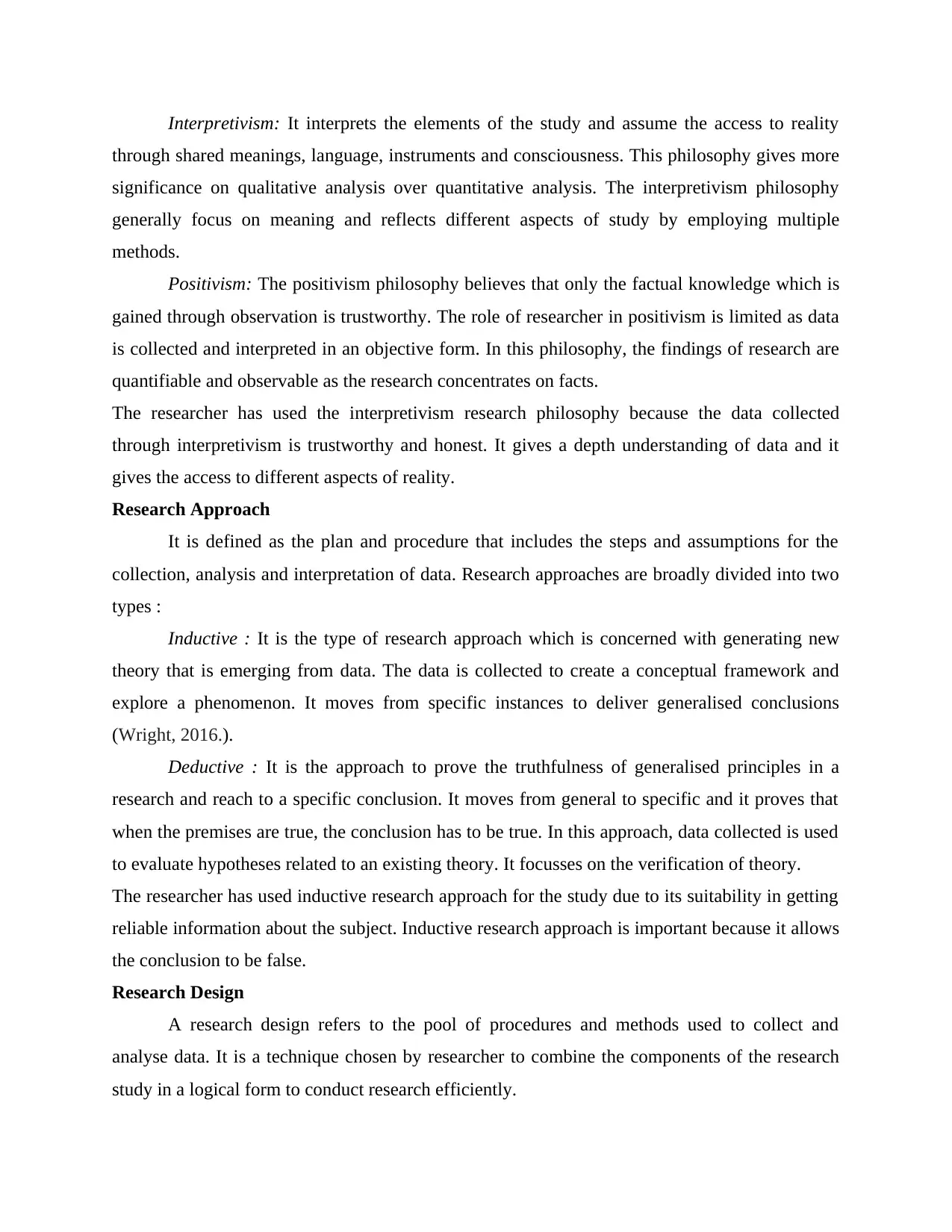
Interpretivism: It interprets the elements of the study and assume the access to reality
through shared meanings, language, instruments and consciousness. This philosophy gives more
significance on qualitative analysis over quantitative analysis. The interpretivism philosophy
generally focus on meaning and reflects different aspects of study by employing multiple
methods.
Positivism: The positivism philosophy believes that only the factual knowledge which is
gained through observation is trustworthy. The role of researcher in positivism is limited as data
is collected and interpreted in an objective form. In this philosophy, the findings of research are
quantifiable and observable as the research concentrates on facts.
The researcher has used the interpretivism research philosophy because the data collected
through interpretivism is trustworthy and honest. It gives a depth understanding of data and it
gives the access to different aspects of reality.
Research Approach
It is defined as the plan and procedure that includes the steps and assumptions for the
collection, analysis and interpretation of data. Research approaches are broadly divided into two
types :
Inductive : It is the type of research approach which is concerned with generating new
theory that is emerging from data. The data is collected to create a conceptual framework and
explore a phenomenon. It moves from specific instances to deliver generalised conclusions
(Wright, 2016.).
Deductive : It is the approach to prove the truthfulness of generalised principles in a
research and reach to a specific conclusion. It moves from general to specific and it proves that
when the premises are true, the conclusion has to be true. In this approach, data collected is used
to evaluate hypotheses related to an existing theory. It focusses on the verification of theory.
The researcher has used inductive research approach for the study due to its suitability in getting
reliable information about the subject. Inductive research approach is important because it allows
the conclusion to be false.
Research Design
A research design refers to the pool of procedures and methods used to collect and
analyse data. It is a technique chosen by researcher to combine the components of the research
study in a logical form to conduct research efficiently.
through shared meanings, language, instruments and consciousness. This philosophy gives more
significance on qualitative analysis over quantitative analysis. The interpretivism philosophy
generally focus on meaning and reflects different aspects of study by employing multiple
methods.
Positivism: The positivism philosophy believes that only the factual knowledge which is
gained through observation is trustworthy. The role of researcher in positivism is limited as data
is collected and interpreted in an objective form. In this philosophy, the findings of research are
quantifiable and observable as the research concentrates on facts.
The researcher has used the interpretivism research philosophy because the data collected
through interpretivism is trustworthy and honest. It gives a depth understanding of data and it
gives the access to different aspects of reality.
Research Approach
It is defined as the plan and procedure that includes the steps and assumptions for the
collection, analysis and interpretation of data. Research approaches are broadly divided into two
types :
Inductive : It is the type of research approach which is concerned with generating new
theory that is emerging from data. The data is collected to create a conceptual framework and
explore a phenomenon. It moves from specific instances to deliver generalised conclusions
(Wright, 2016.).
Deductive : It is the approach to prove the truthfulness of generalised principles in a
research and reach to a specific conclusion. It moves from general to specific and it proves that
when the premises are true, the conclusion has to be true. In this approach, data collected is used
to evaluate hypotheses related to an existing theory. It focusses on the verification of theory.
The researcher has used inductive research approach for the study due to its suitability in getting
reliable information about the subject. Inductive research approach is important because it allows
the conclusion to be false.
Research Design
A research design refers to the pool of procedures and methods used to collect and
analyse data. It is a technique chosen by researcher to combine the components of the research
study in a logical form to conduct research efficiently.
Paraphrase This Document
Need a fresh take? Get an instant paraphrase of this document with our AI Paraphraser
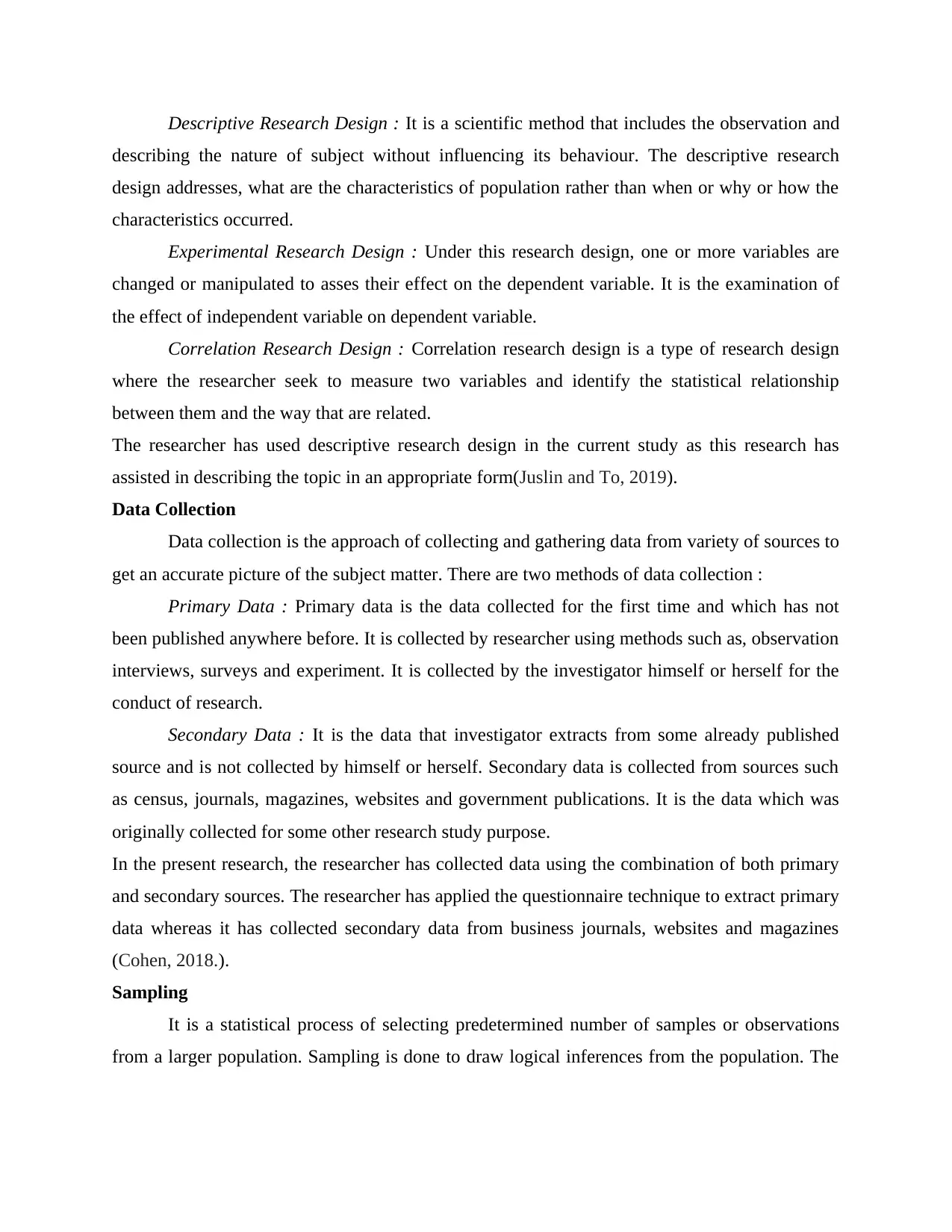
Descriptive Research Design : It is a scientific method that includes the observation and
describing the nature of subject without influencing its behaviour. The descriptive research
design addresses, what are the characteristics of population rather than when or why or how the
characteristics occurred.
Experimental Research Design : Under this research design, one or more variables are
changed or manipulated to asses their effect on the dependent variable. It is the examination of
the effect of independent variable on dependent variable.
Correlation Research Design : Correlation research design is a type of research design
where the researcher seek to measure two variables and identify the statistical relationship
between them and the way that are related.
The researcher has used descriptive research design in the current study as this research has
assisted in describing the topic in an appropriate form(Juslin and To, 2019).
Data Collection
Data collection is the approach of collecting and gathering data from variety of sources to
get an accurate picture of the subject matter. There are two methods of data collection :
Primary Data : Primary data is the data collected for the first time and which has not
been published anywhere before. It is collected by researcher using methods such as, observation
interviews, surveys and experiment. It is collected by the investigator himself or herself for the
conduct of research.
Secondary Data : It is the data that investigator extracts from some already published
source and is not collected by himself or herself. Secondary data is collected from sources such
as census, journals, magazines, websites and government publications. It is the data which was
originally collected for some other research study purpose.
In the present research, the researcher has collected data using the combination of both primary
and secondary sources. The researcher has applied the questionnaire technique to extract primary
data whereas it has collected secondary data from business journals, websites and magazines
(Cohen, 2018.).
Sampling
It is a statistical process of selecting predetermined number of samples or observations
from a larger population. Sampling is done to draw logical inferences from the population. The
describing the nature of subject without influencing its behaviour. The descriptive research
design addresses, what are the characteristics of population rather than when or why or how the
characteristics occurred.
Experimental Research Design : Under this research design, one or more variables are
changed or manipulated to asses their effect on the dependent variable. It is the examination of
the effect of independent variable on dependent variable.
Correlation Research Design : Correlation research design is a type of research design
where the researcher seek to measure two variables and identify the statistical relationship
between them and the way that are related.
The researcher has used descriptive research design in the current study as this research has
assisted in describing the topic in an appropriate form(Juslin and To, 2019).
Data Collection
Data collection is the approach of collecting and gathering data from variety of sources to
get an accurate picture of the subject matter. There are two methods of data collection :
Primary Data : Primary data is the data collected for the first time and which has not
been published anywhere before. It is collected by researcher using methods such as, observation
interviews, surveys and experiment. It is collected by the investigator himself or herself for the
conduct of research.
Secondary Data : It is the data that investigator extracts from some already published
source and is not collected by himself or herself. Secondary data is collected from sources such
as census, journals, magazines, websites and government publications. It is the data which was
originally collected for some other research study purpose.
In the present research, the researcher has collected data using the combination of both primary
and secondary sources. The researcher has applied the questionnaire technique to extract primary
data whereas it has collected secondary data from business journals, websites and magazines
(Cohen, 2018.).
Sampling
It is a statistical process of selecting predetermined number of samples or observations
from a larger population. Sampling is done to draw logical inferences from the population. The
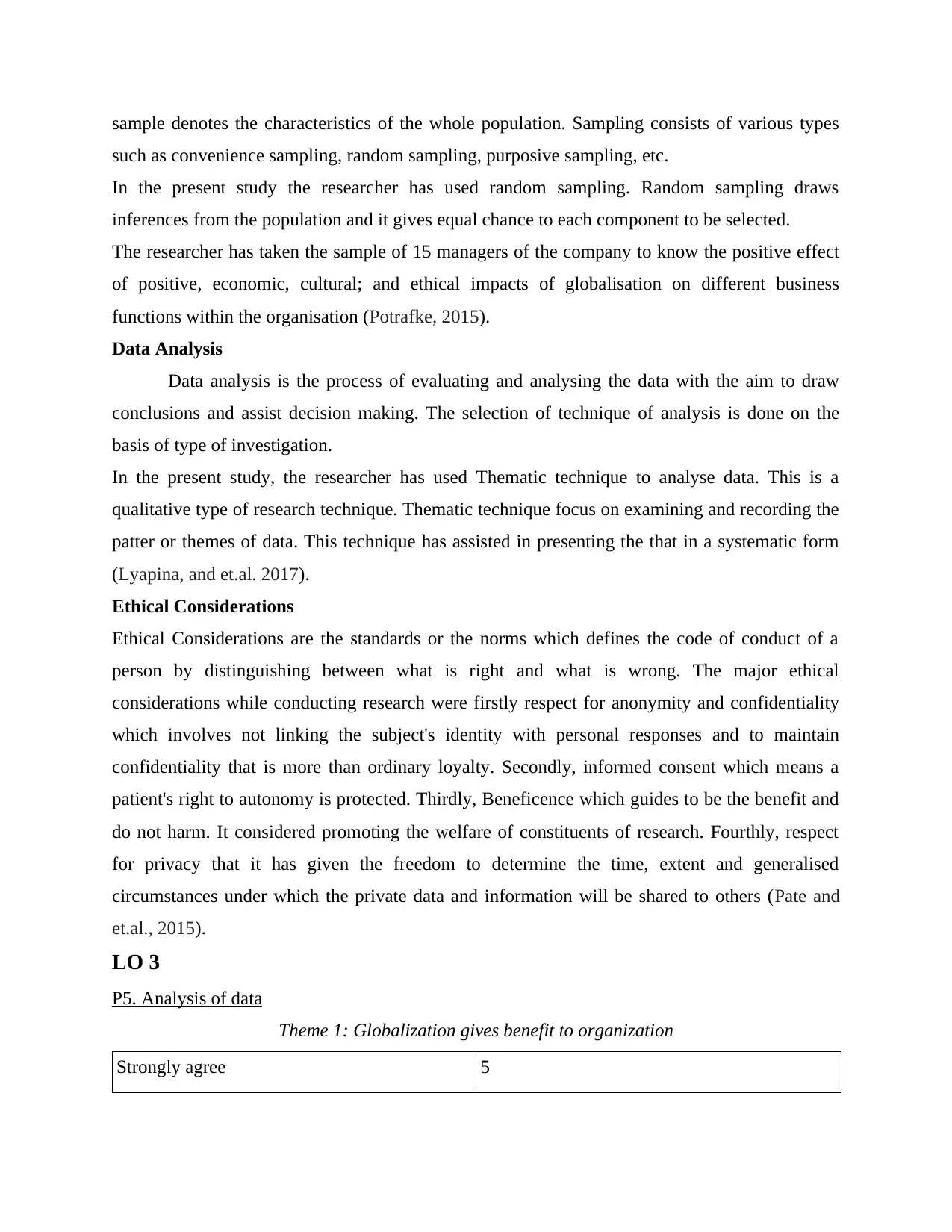
sample denotes the characteristics of the whole population. Sampling consists of various types
such as convenience sampling, random sampling, purposive sampling, etc.
In the present study the researcher has used random sampling. Random sampling draws
inferences from the population and it gives equal chance to each component to be selected.
The researcher has taken the sample of 15 managers of the company to know the positive effect
of positive, economic, cultural; and ethical impacts of globalisation on different business
functions within the organisation (Potrafke, 2015).
Data Analysis
Data analysis is the process of evaluating and analysing the data with the aim to draw
conclusions and assist decision making. The selection of technique of analysis is done on the
basis of type of investigation.
In the present study, the researcher has used Thematic technique to analyse data. This is a
qualitative type of research technique. Thematic technique focus on examining and recording the
patter or themes of data. This technique has assisted in presenting the that in a systematic form
(Lyapina, and et.al. 2017).
Ethical Considerations
Ethical Considerations are the standards or the norms which defines the code of conduct of a
person by distinguishing between what is right and what is wrong. The major ethical
considerations while conducting research were firstly respect for anonymity and confidentiality
which involves not linking the subject's identity with personal responses and to maintain
confidentiality that is more than ordinary loyalty. Secondly, informed consent which means a
patient's right to autonomy is protected. Thirdly, Beneficence which guides to be the benefit and
do not harm. It considered promoting the welfare of constituents of research. Fourthly, respect
for privacy that it has given the freedom to determine the time, extent and generalised
circumstances under which the private data and information will be shared to others (Pate and
et.al., 2015).
LO 3
P5. Analysis of data
Theme 1: Globalization gives benefit to organization
Strongly agree 5
such as convenience sampling, random sampling, purposive sampling, etc.
In the present study the researcher has used random sampling. Random sampling draws
inferences from the population and it gives equal chance to each component to be selected.
The researcher has taken the sample of 15 managers of the company to know the positive effect
of positive, economic, cultural; and ethical impacts of globalisation on different business
functions within the organisation (Potrafke, 2015).
Data Analysis
Data analysis is the process of evaluating and analysing the data with the aim to draw
conclusions and assist decision making. The selection of technique of analysis is done on the
basis of type of investigation.
In the present study, the researcher has used Thematic technique to analyse data. This is a
qualitative type of research technique. Thematic technique focus on examining and recording the
patter or themes of data. This technique has assisted in presenting the that in a systematic form
(Lyapina, and et.al. 2017).
Ethical Considerations
Ethical Considerations are the standards or the norms which defines the code of conduct of a
person by distinguishing between what is right and what is wrong. The major ethical
considerations while conducting research were firstly respect for anonymity and confidentiality
which involves not linking the subject's identity with personal responses and to maintain
confidentiality that is more than ordinary loyalty. Secondly, informed consent which means a
patient's right to autonomy is protected. Thirdly, Beneficence which guides to be the benefit and
do not harm. It considered promoting the welfare of constituents of research. Fourthly, respect
for privacy that it has given the freedom to determine the time, extent and generalised
circumstances under which the private data and information will be shared to others (Pate and
et.al., 2015).
LO 3
P5. Analysis of data
Theme 1: Globalization gives benefit to organization
Strongly agree 5
⊘ This is a preview!⊘
Do you want full access?
Subscribe today to unlock all pages.

Trusted by 1+ million students worldwide
1 out of 32
Related Documents
Your All-in-One AI-Powered Toolkit for Academic Success.
+13062052269
info@desklib.com
Available 24*7 on WhatsApp / Email
![[object Object]](/_next/static/media/star-bottom.7253800d.svg)
Unlock your academic potential
Copyright © 2020–2025 A2Z Services. All Rights Reserved. Developed and managed by ZUCOL.





